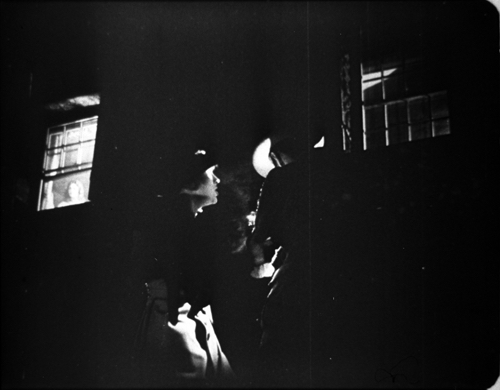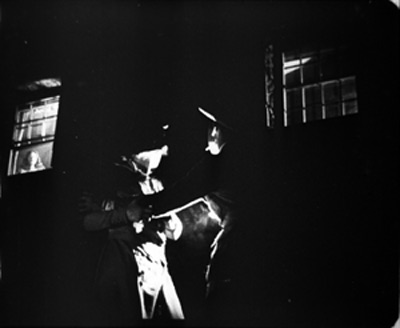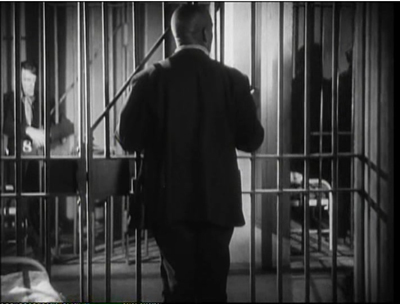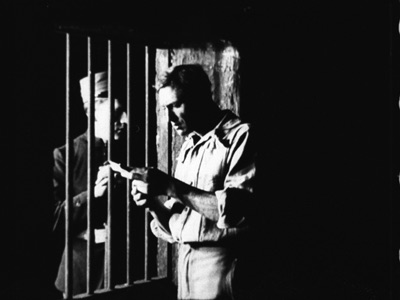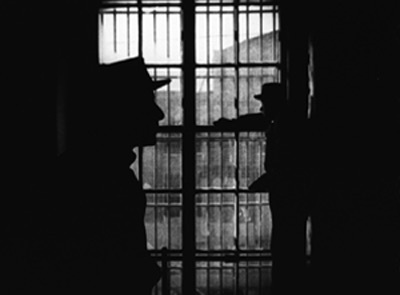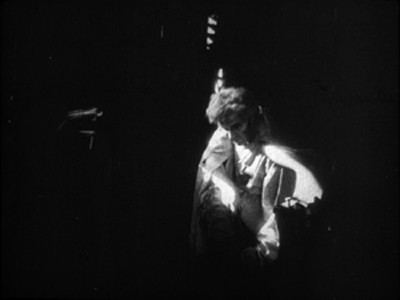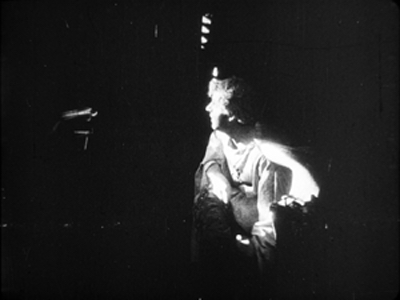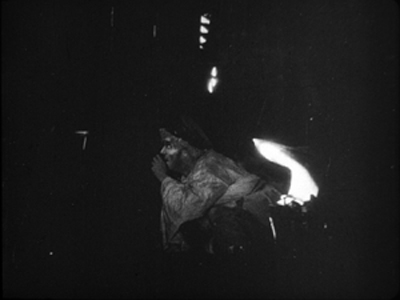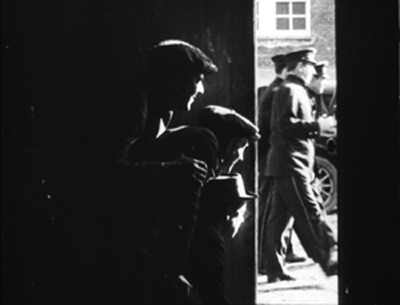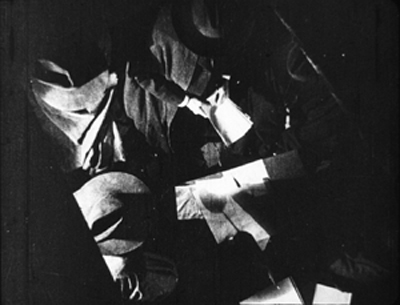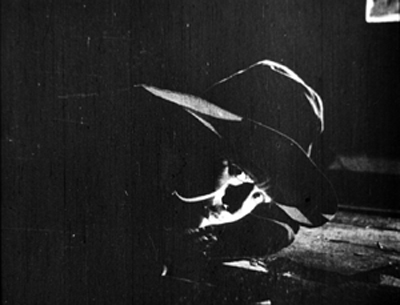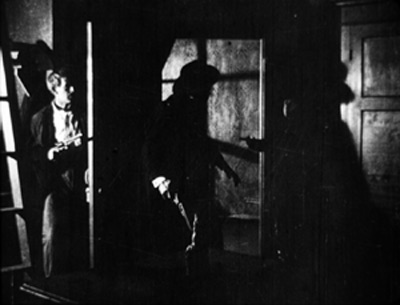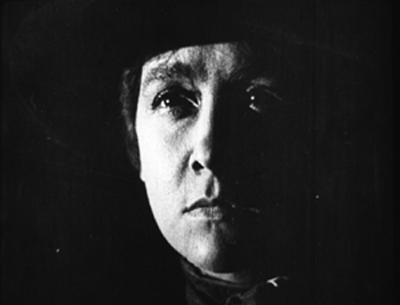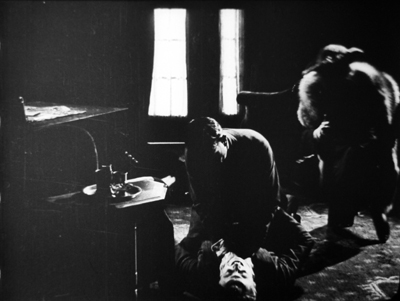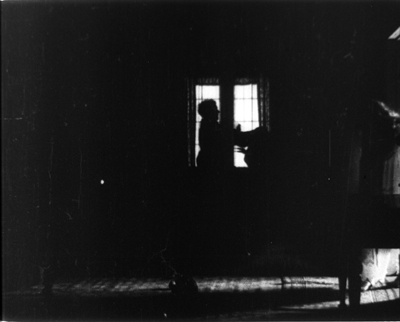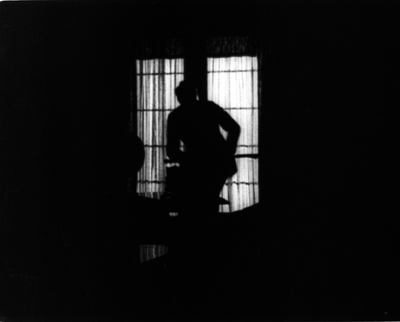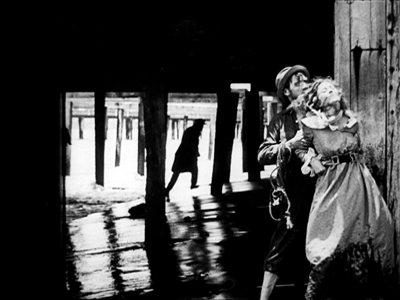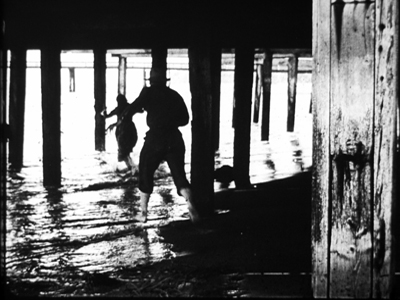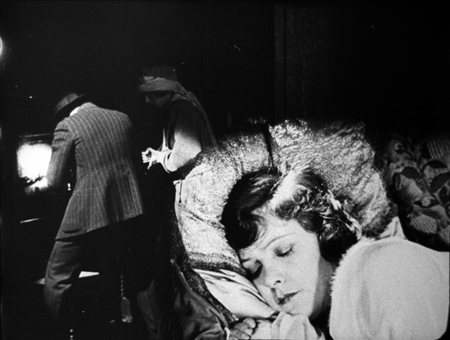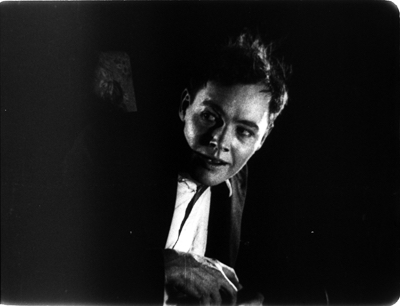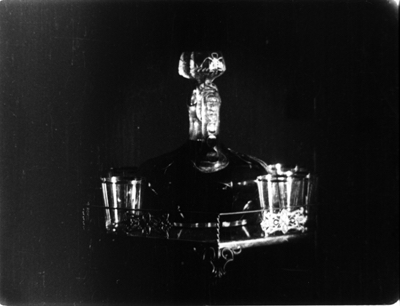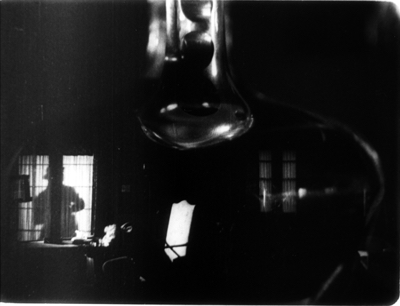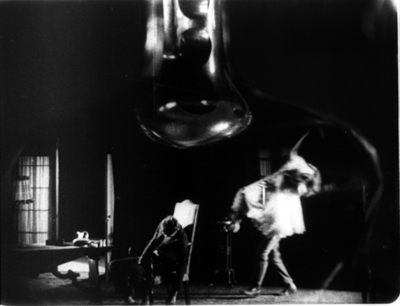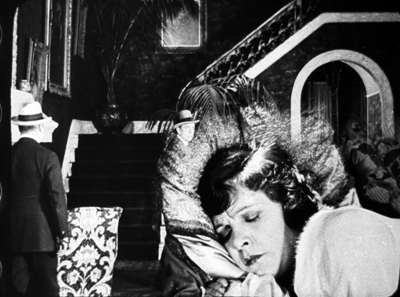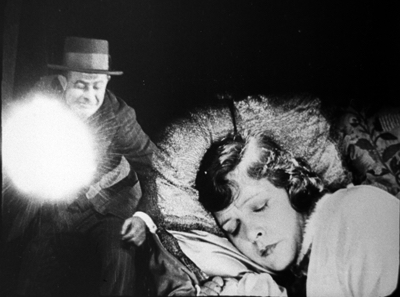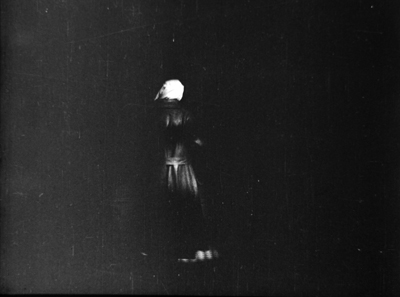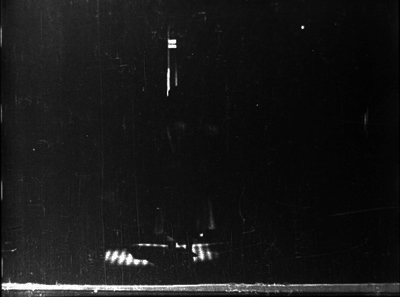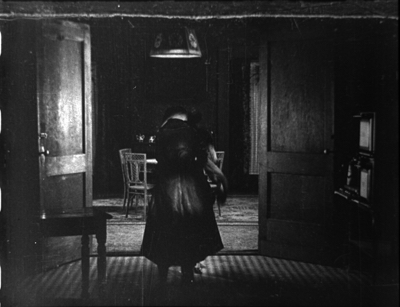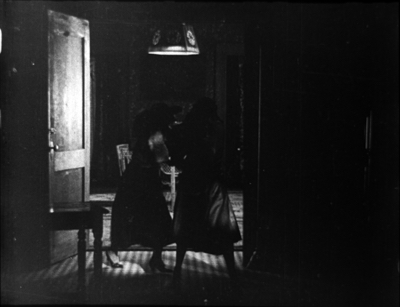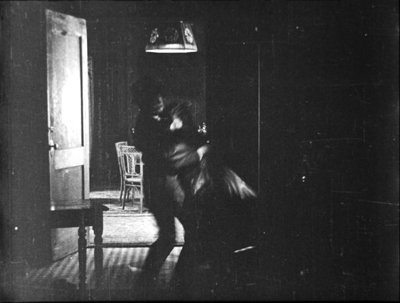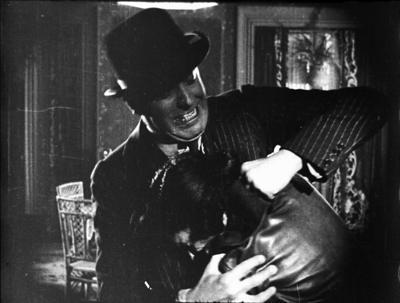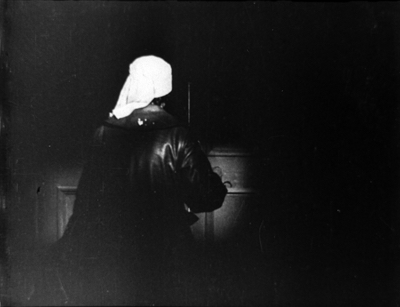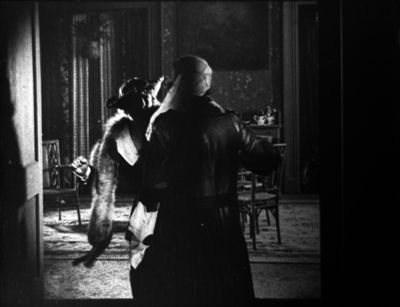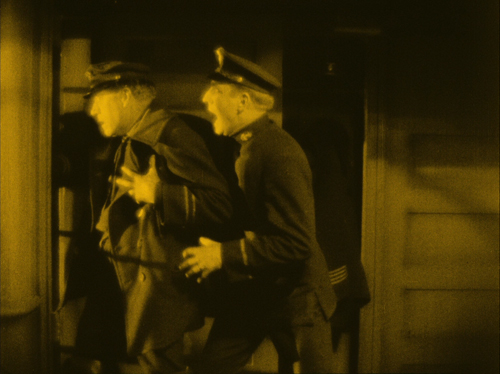Film noir, a hundred years ago
Tuesday | April 18, 2017 open printable version
open printable version
A Romance of the Air (1918).
DB here:
One of the most persistent conventions in American cinema associates dark images with dangerous doings—crime, mystery, violence, espionage, sexual depredations, visits from beyond the grave. The strategy is most apparent in what critics eventually called film noir. Those 1940s “films of darkness” are sometimes said to derive from German Expressionist cinema, but the look was already a Hollywood tradition. Filmmakers had long treated scenes of mystery and suspense with hard, low-key lighting that yielded rich chiaroscuro.
When does it start? You can find very early examples, but it seems to have crystallized during the 1910s. Kristin has talked about this as a period when filmmakers were collectively struggling to tell somewhat lengthy stories in a clear fashion. Along with clarity, she argues, came efforts to add emotional impact to a scene. Those included dynamic staging, fast cutting, close-up framings, subtle but arresting performance styles, ambitious camera movements, and lighting that enhanced the mood of the action. She points to many European and American films of the years 1912-1916 that flaunt silhouettes and selective lighting.
I found a lot of prototypes of noirish images during my recent trawling through Library of Congress films from 1914-1918. In this era, it seems, filmmakers competed to create striking, even shocking, lighting effects. Later directors and cinematographers would adopt many of them as proven tools for boosting their scenes’ emotional power.
So today’s entry is mostly just some pictures that try to convince you, once more, that the 1910s laid down a great deal of what we take for granted in films ever since. You may want to turn up your display. We’re going dark.
No sunshine here
Start with the shot up top, from the independent production A Romance of the Air (1918). Produced by and starring Bert Hall, flyboy and author of the source book, it traces how German spies posing as French refugees win his confidence and try to steal secrets about troop movements. It was released in the month of the Armistice, and it got what appears to be a welcome reaction from audiences.
A Romance of the Air, nearly amateurish in its opening stretches, gets more competent as it goes along. But there’s only one real uptick from a pictorial viewpoint. Two spies have attempted to gas Edith, Bert’s sweetheart, but fortunately their incompetence leads them to the wrong room. They meet outside the house, and suddenly we get a shot that had me hollering.
As the man lights a cigarette, a low-slung angle shows the flare of the match illuminating his hatbrim and the countess beside him. In the upper left Edith peers down from a window. We might be in Hollywood, 1945, perhaps in the hands of production designer William Cameron Menzies or ace DP John Alton.
It’s interesting that a title pops in here, coaxing the audience to notice the face at the window.
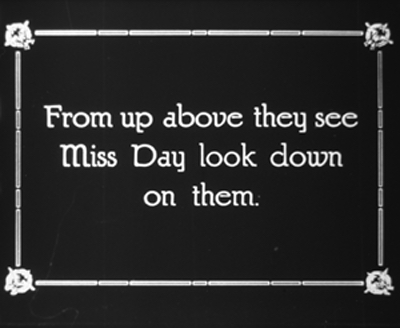
The mistaken placement of “From up above” tells you something of the clumsiness of this whole production. Yet bad grammar is redeemed when we return to the framing as the spies twist around in surprise and the man clutches the countess.
Other filmmakers of the period would have trusted the audience to spot Edith, but nonetheless an undistinguished, forgotten film bequeathes us one bold moment.
We can see a more conventional look emerging when characters get sent to jail. By the end of the 1920s, filmmakers had found a way to crosslight cell bars to make them stand out crisply, as here in von Sternberg’s Thunderbolt (1929).
A jail scene in The Unknown (1915) isn’t so flashy, but the concept of edge-lighting the bars is there. If all you wanted was clarity, the naked cell door suffices, but the sidelight makes the barrier more vivid.
At this point, some directors were willing to leave large patches of the image in darkness, even at the risk of off-balance compositions. This is not only expressive; it saves money on set construction. So trust Maurice Tourneur to go further. In Alias Jimmy Valentine (1915), one of the most accomplished films of the era, we get cons as patient silhouettes.
No need to see their expressions; the outlines of their poses express their resignation.
Speaking of prisoners, consider the plight of Ivanoff, the revolutionary who has been sentenced to Siberia in Cecil B. DeMille’s The Man from Home (1914). He has escaped from the mines and taken refuge in a stable. Filing off his chains, he crouches as guards pass by outside. First, he’s in a glare, but when he hears them….
… he shifts into semi-shadow.
The guards’ approach is measured by a barely noticeable change: the gleaming surface on the far left is briefly darkened.
This is a bold instance of “Lasky lighting,” the brilliant effects which DeMille worked up with Wilfred Buckland, Belasco’s stage designer. Several films in my sample exemplify this style, which became part of Jesse Lasky’s Paramount brand. Examples are comparatively abundant because many Paramount films have survived from the silent era.
Camera obscura
In A Romance of the Air, the darkness is motivated as a night scene, and naturally prisons and hiding places are associated with danger. Another option is to stage scenes in darkened rooms, populated by sneaking and skulking characters. Again, the association with criminality is evident. In Alias Jimmy Valentine, hoods hide from cops and are visible thanks to diagonal edge lighting.
More dynamic are two suspense scenes in Madam Who (1918), the story of a plucky Southern belle who goes undercover for the Confederate cause. In the first, disguised as a man, she peers down from a hayloft to watch the meeting of the Sons of the North gang. We get an optical POV shot straight down, and then a close reaction shot, with a fish-hook of light snagging her face as she glances at us.
Reginald Barker, one of the most resourceful directors of the era, didn’t let up in a later scene of Madam Who. Jeanne and the secret agent Henry Morgan get the drop on the Sons’ leader Kennedy. The action plays out in layers of darkness, with her poking a pistol through the doorway right of center, and it’s capped by a stark close-up.
In the late 1910s, several directors use such darkened interiors for fight scenes. In De Luxe Annie (1918), the heroine’s husband takes a brutal beating from the criminal he’s trapped. The accomplice runs to administer a hypodermic.
Something similar happens in The Family Skeleton (1918), when dissolute Billy (Charles Ray) battles the bully who has tormented him throughout the movie.
Shadow-filled rooms help amp up suspense during fistfights. We can’t be sure who’s winning, and the enveloping darkness can also suggest more savage violence than could be shown in normal light.
Or you can stage a fight or a chase in a darkened area outdoors. The Sign of the Spade (1918) sets its climactic abduction and rescue under a seaside pier, and the silhouettes that result would not have shamed Panic in the Streets (1950).
As with the jail in Jimmy Valentine, we have to read the characters’ emotions–chiefly, the desperation of the fleeing woman–from their body language. And as often happens, the more we have to strain to see the action, the more gripping it becomes.
Billy and two Annies
De Luxe Annie (1918).
Of course what we call film noir includes more than visual style. Like many terms in the arts, film noir picks out a cluster concept. It links together distinctive subjects (urban life, abnormal mental states, misogyny), attitudes (alienation, nihilism, malaise, mistrust of authority and the upper class), themes (official corruption, revenge, male friendship and betrayal), plots (investigation, pursuit, deception), narrational devices (flashbacks, voice-over commentary, dreams and hallucinations), and visual techniques. Because noir is a cluster concept, eager acolytes can choose some noir-ish qualities of Film A and declare it a more or less plausible instance, while with Film B a quite different set of features might help it qualify too.
For example, in visual technique, only a few shots of Laura carry traces of the lighting style we think characteristic of noir. But the film does present a decadent, treacherous milieu harboring a mysterious, perhaps dangerous woman who may be feeding a man’s delusions and obsessions. Laura, I’d suggest, counts as a noir on thematic and narrative grounds more than on stylistic ones.
So do we find non-stylistic features of noir in the 1910s? Sometimes, yes. I’ll save my prime example, an intricate and beautiful thing, for an entry of its own. But here are two nifty cases where the visual pyrotechnics spring from noirish narrative and thematic pressures.
Billy Bates is warned that alcoholism runs in his family, but on getting his inheritance he holds a party and learns that he likes the stuff. Not needing to work, he keeps drinking. He falls in love with chorus girl Poppy Drayton, but when she’s insulted in a saloon he’s too crocked to defend her from the hulking Spider, who beats and shames him. Billy learns that Spider is planning to abduct Poppy and so lays a trap. He waits in Polly’s parlor, resolving to stay sober long enough to defend her. Unfortunately, there’s a decanter of scotch within easy reach….
The Family Skeleton (1918) was touted as a “semi-farcical production” but the semi- parts took alcohol addiction fairly seriously. The popular Ray often played the country-boy underdog, so audiences were probably unprepared to see him as a millionaire twitching from the D.T.’s. The scenes of his drunkenness are truly unnerving, even when the plot is lightened by the revelation that Spider is a detective hired by Poppy to force Billy to man up. Billy does, in the nocturnal fistfight illustrated above. There darkness makes Billy’s ultimate victory more plausible; we can’t really see his winning punches.
In the buildup to the fight, however, we get Billy’s growing anxiety over the scotch across the room. He stares at the decanter.
A cut shows us a condensed mental image: what would happen if he drank the contents. In this hypothetical future, the decanter is empty, and in it we see Spider breaking in and carrying off Polly while drunken Billy lolls helplessly.
As in the hallucinations of The Lost Weekend (1945), the filmmaker has taken us inside the addict’s fantasy.
Other subjective effects, like memories and dreams, were common in silent cinema too, though usually not plunged so deeply in darkness. In De Luxe Annie, Julie Kendall is worried that her husband is taking a risk by setting a trap for two dangerous swindlers. He will pose as an innocent mark and then arrest them when they try to con him. Julie’s concern emerges in a virtuoso split-screen dream sequence in which her husband is shot by the crook.
Later in the film, Julie will lose her memory and become the con man’s confederate, the new De Luxe Annie. The screenwriter’s old friend amnesia transforms an upper-class wife into down-at-heel swindler.
What triggers the amnesia? The most remarkable scene in the film. It’s either a brilliant coup or a happy accident, but either way it can stand as proof of the boiling energies of this era.
Worried about her husband, Julie follows him to the site of his trap. She goes in through the basement kitchen and enters almost total blackness. She stands in a tiny pool of light before a big double door, and it opens a crack.
Suddenly, and I mean instantly, the doors are wide open and we get a burst of light.
A jump cut has eliminated the movement of the doors swinging apart. (You can see the splice at the bottom of the second frame and the top of the third.) This is a very bold stylistic flourish.
Kristin suggests that it’s something of an accident. The overhead kitchen light is now lit up, and it was common at the time to cut out some frames when a light source is snapped on. That may be what led to this jump cut, though it’s not clear how anyone in the scene could have hit the power switch. In any event, the force of the cut is amplified by the ellipsis; the doors simply pop open.
Another pictorial surprise emerges when Julie moves a bit and it’s revealed that her figure has blocked De Luxe Annie, who’s facing her over the threshold. They start to grapple with one another and move into darkness on the right.
Annie runs off, but Jimmy the con man is fleeing too, and he shows up to wrestle with Julie. A slamming axial cut shows him punching her fiercely in the head. The edge lighting here is remarkable.
Jimmy gets away, leaving Julie to stagger out and into the fog. She’s contracted amnesia. Later she’ll meet Jimmy again and become his new partner in crime.
This scene is even replayed as a brief flashback, when the original Annie recounts to Jennie’s husband the clash that led to Julie’s disappearance.
This is presented in a more unsurprising way, since there’s nothing new to be learned about the fight. The shot shows the full swinging open of the doors and a clearer revelation of Annie’s presence.
All this won’t be news to aficionados of silent film, who are well aware that the 1910s, and then the 1920s, burst with ingenious creativity. But everybody needs reminding, and the rare films I was lucky enough to study are just part of a huge corpus. The official classics by Chaplin and Griffith and others can be restored and reissued again and again, and we’re grateful. Yet if they’re the peaks of a landscape, there are plenty of luscious valleys that remain unexplored.
Problem is, most of the films from which my scenes come are incomplete, often missing entire reels. So they’ll probably never be screened much, or made available on DVD or streaming services. This is why archives remain indispensable to keeping the entirety of our film heritage, fragments and all, available to researchers. It’s also why I wrote this entry, to share with you my enjoyment of films you may never have a chance to see.
More broadly, scenes like these help us nuance our thinking about those films we do know well. For one thing, they indicate just how rich the creative energies of the 1910s were, and how many options were not embraced by…oh, let’s say for example D. W. Griffith.
For another thing, if these neglected works throw up willy-nilly an alcoholic’s hallucinations, an anxious wife’s dream, a plot based on amnesia, and a strategic replay of a crucial scene, we ought to think twice about claiming that such storytelling strategies are somehow unique to film noir, or the zeitgeist of the 1940s–or our movies today, which continue to use them.
American commercial cinema has drawn on particular themes, plot structures, formal designs, and narrational strategies again and again throughout the decades. My book Reinventing Hollywood floats the claim that silent-cinema narrative devices like flashbacks and subjective sequences went somewhat quiet during the 1930s but were brought back fortissimo in the 1940s, when sound techniques could raise them to a new level of intensity. And I’ve been at pains to argue over the years that we still encounter them.
Again, no surprise once we think about it. This is just history at work: the continuity of a powerful, proven storytelling tradition. Once we’ve learned to love darkness, we can’t give it up.
Again I must give my thanks to the John W. Kluge Center for providing me a long stay at the Library of Congress. The Moving Image Research Center was my host, and so I’m grateful to Mike Mashon, Greg Lukow, Karen Fishman, Dorinda Hartmann, Josie Walters-Johnston, Zoran Sinobad, and Rosemary Hanes. They’re doing their utmost to preserve our film heritage.
For information on the survival of US silent films, download David Pierce’s indispensable study, done for the Library of Congress. The information on Paramount is on p. 41.
Kristin’s article is “The International Exploration of Cinematic Expressivity,” in Film and the First World War, ed. Karel Dibbets and Bert Hogenkamp (Amsterdam University Press, 1995), 65-85. She discusses American lighting practices of the period in The Classical Hollywood Cinema: Film Style and Mode of Production to 1960 (Columbia University Press, 1985), 223-227. In the same volume in discussing film noir I consider the established practice of chiaroscuro for scenes involving crime and mystery (p. 77).
The most in-depth account of Paramount’s lighting styles is Lea Jacobs’ article “Belasco, DeMille and the Development of Lasky Lighting,” Film History 5, 4 (December 1993), 405-418. This is a good place to record my deep debt to Kristin, Lea, and Ben Brewster, for years of tutelage in what makes the 1910s so important.
There are many good books on film noir, but the most comprehensive reflection on the category’s many implications is James Naremore’s More Than Night: Film Noir and Its Contexts, 2d ed. (University of California Press, 2008).
For more on 1910s film style, see this video lecture and this category of blog entries. I talk about other forays into the LoC collections here and here.
Lately, two video distributors have brought out less-known films from the period. There’s DeMille’s The Captive (1915) from Olive, and Irvin Willat’s Behind the Door (1919). The somewhat noirish frame below is from the latter. Flicker Alley, whose commitment to silent cinema from all countries has been extraordinary, deserves our thanks for making the San Francisco Silent Film Society’s restoration of this sensational, and sensationalistic, film available. For more on this restoration, visit the Flicker Alley site.
Behind the Door (1919).












